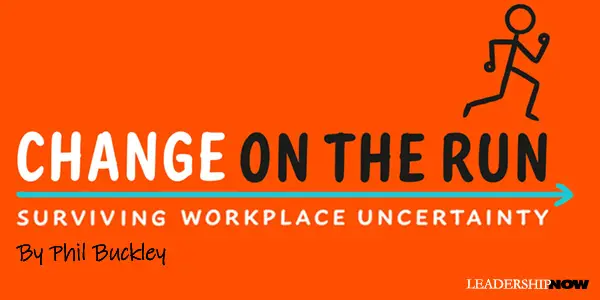 |
 |
07.23.21

Change on the Run: Surviving Workplace Uncertainty
IF THE ADAGE “the only constant is change” described our pre-pandemic lives, “the only thing you can rely on is uncertainty” expresses our current realities. Changes have never been at a higher rate or faster pace than they are right now. Most people grapple with multiple disruptions, from hybrid teams to restructuring, digital transformations, and mergers and acquisitions. Uncertainty is now a workplace norm, and quickly managing new circumstances is a must-have survival and success capability. Why Uncertainty is Difficult The biggest challenge most leaders and managers face is deciding what to do when confronted with a new situation. Their career experience doesn’t provide the context needed to quickly take the best action that will move them forward. A marketing manager, for example, can easily create a brand positioning statement for a new brand—they have the knowledge, skill, and experience to draw upon. However, this doesn’t apply to change initiatives where the type of change, the context for it, and the project team are new. Their functional experience provides little guidance, especially when objectives and stakeholders span across their organization. Managing Uncertainty Many leaders take multiple actions when faced with uncertainty, hoping that something will address the situation. Often, trying everything achieves nothing because their efforts are uncoordinated and conflicting with insufficient resources to execute well. This approach often gives leaders poor results and a reputation for not being at their best. The best strategy for managing uncertainty is to focus your efforts on one action that will give you the best results. Typically, it will give you 80 percent of the results in 20 percent of the time and free you up to move on to the next task or issue. You need to excel in three areas of capability when managing uncertainty: managing me, managing the work, and managing others. Managing Me is the ability to be your best while accommodating a fast-moving change agenda; Managing the Work is about understanding the steps and activities to progress through a transition; and Managing Others is about aligning people on goals and enabling them to work collaboratively to achieve them. Each one contains situations you or your stakeholders may face or tasks you need to address to succeed. Let’s take a look at an example from each area to see how focusing on one action can give you 80 percent of the results in 20 percent of the time. Managing Me: Managing the Unknown Unknown situations are challenging because we can’t rely on our experience to guide our thoughts, actions, or behaviors; we don’t know what to do. To manage the unknown, take stock of what you know and don’t know. Creating lists for each will form a clearer picture that often looks like something you’ve seen in the past. The three steps to do so are:
Evaluating what you know and don’t know will transform the information you have into something more than the sum of its parts, moving you into more familiar territory. Managing the Work: Communication Effectively Good communication is the most important form of support people receive when going through times of uncertainty. It’s also the biggest enabler of successful change because it aligns everyone on their understanding of what’s changing, why it’s necessary, how it will affect them and what they must do to adopt it. Focusing on always being the best source of information ensures that people are guided by your messages and can ignore informal ones that are misaligned or incorrect. The three steps to do so are:
People seek out the most credible information they can find. Providing timely, complete, honest, and relevant updates ensures they will seek out, listen to, and be guided by you. Managing Others: Earning Trust Trust is the antidote to fear of uncertainty. Without it, people spend their energy protecting themselves from harm. When meeting someone new or learning about an unclear change, people’s “fight, flight or freeze” response is often triggered, causing them to either defend their territory or hide. Both responses add risk and slow you down. When people have trust, they collaborate toward a common goal even when it is not fully defined. People rarely trust those who don’t trust them. Demonstrating your faith in them by asking for their help inspires the same response toward you. The three steps to trusting first are:
Being indebted to someone provides an opportunity to support them, which creates a bond of trustworthiness. When people trust each other, they form a partnership that combines abilities and resources to address uncertainty. Managing uncertainty is a reality we all face in our current workplaces. We are moving into new territory with experience to draw upon. The best strategy is to focus our efforts on the actions that will give us the best results, the ones that will give us 80 percent of the benefits in 20 percent of the time. You will accomplish more, have more time for other tasks, build your change capabilities and your confidence, too.  
Posted by Michael McKinney at 07:19 AM
|
BUILD YOUR KNOWLEDGE
 

How to Do Your Start-Up Right STRAIGHT TALK FOR START-UPS 
Grow Your Leadership Skills NEW AND UPCOMING LEADERSHIP BOOKS 
Leadership Minute BITE-SIZE CONCEPTS YOU CAN CHEW ON 
Classic Leadership Books BOOKS TO READ BEFORE YOU LEAD |